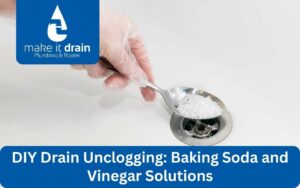Combat shower mold with this easy DIY guide. Learn effective techniques to clean and prevent mold in your shower. Say goodbye to bathroom mildew!
Expert Tips from Make it Drain Plumbing & Rooter
Mold in the shower is a common household problem that can be both unsightly and unhealthy. It thrives in moist environments, making your shower a prime target. Fortunately, with some basic knowledge and household items, you can tackle this issue yourself. In this blog, Make it Drain Plumbing & Rooter, your reliable plumbing company, shares a step-by-step guide on how to effectively clean mold in the shower.
Understanding Mold in the Shower
Before diving into the cleaning process, it’s important to understand what causes mold in showers. Mold growth is typically due to excessive moisture and lack of ventilation. It can appear in various forms, from black spots on shower curtains to pinkish film on shower walls.
1. Preparation
Safety First: Wear gloves, a mask, and eye protection to avoid direct contact with mold and cleaning agents.
Ventilation: Ensure good air circulation by opening windows or using an exhaust fan to reduce fume inhalation.
2. Choosing Your Cleaning Solution
You can use either commercial mold removers or natural solutions like vinegar or baking soda. Vinegar is effective against most mold types and is a non-toxic option, while baking soda not only cleans but also deodorizes.
3. Cleaning Process
Spray the affected area: Liberally apply your chosen cleaning solution to the moldy surfaces. For vinegar, let it sit for an hour before scrubbing. For baking soda, create a paste with water, apply it to the area, and let it sit for a few minutes.
Scrub: Use a brush or sponge to scrub the mold off gently. Avoid using abrasive tools that might damage grout or sealant.
Rinse: After scrubbing, rinse the area thoroughly with water.
Dry: Use a clean towel or squeegee to dry the area completely.
4. Preventing Future Mold Growth
Regular Maintenance: Regularly clean your shower to prevent mold spores from settling.
Improve Ventilation: Use an exhaust fan during and after showers to reduce humidity.
Fix Leaks: Persistent moisture due to leaks can contribute to mold growth. If you suspect a leak, consider consulting professional plumbers.
5. When to Call Professional Plumbers
While DIY methods are effective for minor mold issues, extensive mold growth might indicate underlying plumbing problems, such as leaks inside walls. In such cases, it’s wise to seek plumbing service from experienced professionals like Make it Drain Plumbing & Rooter. Our team can identify and fix any hidden issues to prevent future mold growth.
Conclusion
Cleaning mold in your shower is a straightforward process that can significantly improve the health and appearance of your bathroom. Remember, the key to mold prevention is controlling moisture and ensuring proper ventilation. If you encounter any plumbing-related challenges during your mold cleanup, don’t hesitate to reach out to Make it Drain Plumbing & Rooter for expert assistance. As your go-to plumbing service provider, we’re here to ensure your plumbing system supports a mold-free and healthy home environment.






